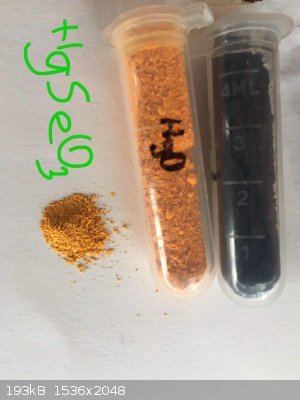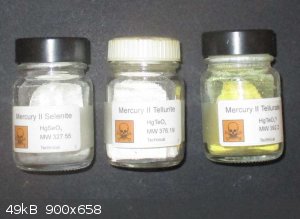vano
National Hazard
   
Posts: 661
Registered: 22-3-2019
Location: Georgia
Member Is Offline
|
|
Mercury selenite
Hi. Today i made mercury selenite, but it has unusual colour. I do not know exactly because I do not have much information. My selenite had exactly that color when it precipitated. If I filtered it and dried it in air, it would be exactly like that, but I evaporated water from
the solution and it got such a color. I think it isnt mercury oxide or selenide, because that compounds have different colours. That's why I think it
did not decomposed.
I used mercury bromide and sodium selenite, i made it from bicarbonate and acid. It was white. It did not contain any selenium particles.
Black is selenide.

|
|
|
Boffis
International Hazard
    
Posts: 1867
Registered: 1-5-2011
Member Is Offline
Mood: No Mood
|
|
Hi Vano, Many years ago I acquired a collection of mercury compounds from a guy who had worked on them in the 1950's at one of the north of England
universities. Looking at my database there should be a small jar of mercury II selenite, tellurite and tellurate but no selenate. Would you like me to
dig them out and send you some photos?
I was wondering about the HgO too. Sometimes if it contains a little Hg+ when reacted with certain reagents causes the separation of metallic mercury
in certain reactions as the Hg+ disproportionates into Hg + Hg2+. I wonder if small amounts of Hg2Br2 in your mercury II bromide could have the same
affect. Also mercury has an insane affinity for free selenium and you mention a little free selenium being present in the sodium selenite so maybe you
have got a little Hg selenide forming too. A very small amount will go a long way to darken you product.
|
|
|
vano
National Hazard
   
Posts: 661
Registered: 22-3-2019
Location: Georgia
Member Is Offline
|
|
I will be very grateful if you send me the photos. I encountered a similar problem with manganese, but checked the color of all other metallic
selenite and it turned out to be correct.
I do not think it is characterized by thermochromism, but I have used the same acid at other times. I also made scandium selenite which is white in
color, if the acid was contaminated then it would also have color. But the compounds I use are very pure. I hate contaminated compounds.
|
|
|
Bedlasky
International Hazard
    
Posts: 1239
Registered: 15-4-2019
Location: Period 5, group 6
Member Is Offline
Mood: Volatile
|
|
Did you dry it at room temperature or at higher temperature? This can change amount of water of hydratation in your compound, which can change its
colour. Look at Sb2S3 - hydrous is orange, anhydrous black. Or CoCl2 - hexahydrate is red, dihydrate violet, anhydrous blue. CuSO4 - pentahydrate
blue, anhydrous white. Etc.
[Edited on 11-1-2021 by Bedlasky]
|
|
|
vano
National Hazard
   
Posts: 661
Registered: 22-3-2019
Location: Georgia
Member Is Offline
|
|
Maybe it is anhydrous. But the strange thing is that the compound itself changed color in solution when boiled.
|
|
|
Bedlasky
International Hazard
    
Posts: 1239
Registered: 15-4-2019
Location: Period 5, group 6
Member Is Offline
Mood: Volatile
|
|
It is possible.
Here is good example - NiSO4. This is what english wiki says about its hydrates:
The common tetragonal hexahydrate crystallizes from aqueous solution between 30.7 and 53.8 °C. Below these temperatures, a heptahydrate
crystallises, and above these temperatures an orthorhombic hexahydrate forms.
|
|
|
vano
National Hazard
   
Posts: 661
Registered: 22-3-2019
Location: Georgia
Member Is Offline
|
|
It is clear. In short it is really selenite.
|
|
|
Bedlasky
International Hazard
    
Posts: 1239
Registered: 15-4-2019
Location: Period 5, group 6
Member Is Offline
Mood: Volatile
|
|
This is just hypothesis, I am not sure if this caused change of colour of your product. Try it again at room temperature, if your product have the
same colour or different.
|
|
|
Boffis
International Hazard
    
Posts: 1867
Registered: 1-5-2011
Member Is Offline
Mood: No Mood
|
|
Well, this is what my samples look like: mercury selenite, tellurite and tellurate,

|
|
|
vano
National Hazard
   
Posts: 661
Registered: 22-3-2019
Location: Georgia
Member Is Offline
|
|
I will prepare again and dry at room temperature.
Thank you Boffis. Tellurate is very beautiful. Some monovalent mercury compounds have a similar color.
|
|
|